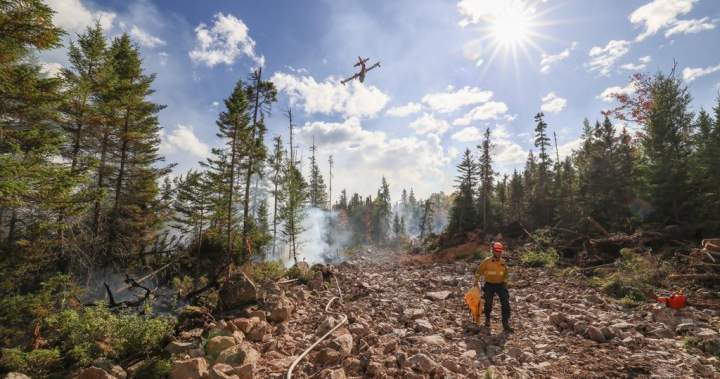Unseasonably warm temperatures and drought conditions in the Maritimes is creating a challenging situation for crews battling an out-of-control wildfire in Nova Scotia, and wreaking havoc on the region’s fish population and farms.
The forecast for New Brunswick and Nova Scotia for Monday is calling for temperatures anywhere from around 20 C to 30 C. The average daily high in the region for October is normally below 15 C.
Officials with Nova Scotia’s Department of Natural Resources says the fire at Lake George in Kings County, which broke out on Sept. 28, is estimated to have grown slightly to just over 2.8 square kilometres — mainly because of dry and windy conditions.
There are no reports of damage to structures in the area around Lake George and the west side of Aylesford Lake.
Officials say the fire is burning deep in the ground and crews are working to protect homes, cottages and other structures.
Dan Stovel, with the Municipality of the County of Kings, says 353 civic addresses have been evacuated to date, including around 79 permanent addresses. Stovel says 391 people from 205 households have registered with the Canadian Red Cross at a shelter in New Minas, N.S.
To exacerbate the situation, the region has not had significant all summer.
Customers in parts of the Halifax area, for example, have been under mandatory water restrictions for nearly a month because reservoirs are running low.
Get breaking National news
For news impacting Canada and around the world, sign up for breaking news alerts delivered directly to you when they happen.
The province recently chose to extend its wildfire season — which typically runs until Oct. 15 — to Oct. 31.
This means the full burn ban will remain in effect in Annapolis County and daily burn restrictions will continue to apply in all other counties until the end of the month.
In New Brunswick, there is also concern that lower water levels is having an impact on the ecosystem — with rivers at historically low levels.
“This is certainly the result of a lack of rain for the last several months going into July. and of course before that, the low snow pack that we had during the winter that resulted in not a lot of a spring freshet this year,”” said Colin Forsythe, the executive director of the St. John River Society.
That means wetlands and reservoirs didn’t adequately get refilled and many bodies of water, especially in the southern parts of the province, are lower than normal.
Forsythe says this can have an impact on salmon and trout because they have fewer places for spawning.
“The (rivers) warm reasonably rapidly so you get temperature effects. If you’re a coldwater species, really hot water is not good news for you,” he said.
“For salmon and trout, anything above 20 degrees at a prolonged exposure is lethal.”
The dry conditions are also affecting farmers.
Don Arseneault, the general manager of Bluets NB Blueberries (BNBB), says farmers lost a week of harvesting because of restrictions in August while out-of-control wildfires were burning.
“We have an average of 68 million pounds of blueberries per year. This year, we’re looking at 20 to 24, so that’s a loss of almost 70 per cent of the production for our farmers,” he said.
“That has a tremendous impact.”
He adds the industry will be approaching the provincial government for help, as some farmers may need to make tough choices in the near future due to financial losses.
— with a file from The Canadian Press
© 2025 Global News, a division of Corus Entertainment Inc.
Unseasonably warm temps fuelling wildfire, affecting crops in Maritimes


